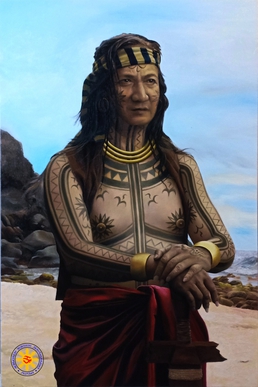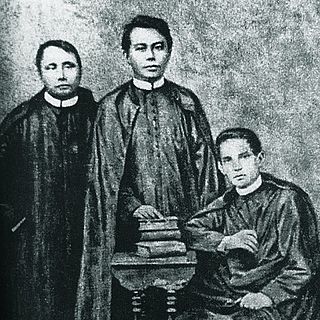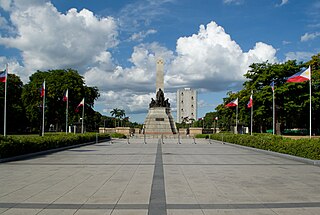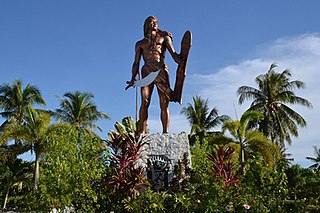
Metropolitan Manila, commonly shortened to Metro Manila and formally the National Capital Region, is the capital region and largest metropolitan area of the Philippines. Located on the eastern shore of Manila Bay, the region lies between the Central Luzon and Calabarzon regions. Encompassing an area of 619.57 km2 (239.22 sq mi) and with a population of 13,484,462 as of 2020, it is composed of sixteen highly urbanized cities: the capital city, Manila, Caloocan, Las Piñas, Makati, Malabon, Mandaluyong, Marikina, Muntinlupa, Navotas, Parañaque, Pasay, Pasig, Quezon City, San Juan, Taguig, and Valenzuela, along with one independent municipality, Pateros. As the second most populous and the most densely populated region in the Philippines, it ranks as the 9th most populous metropolitan area in Asia and the 6th most populous urban area in the world.

Lapulapu or Lapu-Lapu, whose name was first recorded as Çilapulapu, was a datu (chief) of Mactan, an island now part of the Philippines. Lapulapu is known for the 1521 Battle of Mactan, where he and his men defeated Spanish forces led by Portuguese explorer Ferdinand Magellan and his native allies Rajah Humabon and Datu Zula. Magellan's death in battle ended his voyage of circumnavigation and delayed the Spanish occupation of the islands by over forty years until the expedition of Miguel López de Legazpi in 1564.

Gomburza, alternatively stylized as GOMBURZA or GomBurZa, refers to three Filipino Catholic priests, Mariano Gómes, José Burgos, and Jacinto Zamora, who were executed by a garrote on February 17, 1872, in Bagumbayan, Philippines by Spanish colonial authorities on charges of subversion arising from the 1872 Cavite mutiny. The name is a portmanteau of the priests' surnames.

Rizal Day is a Philippine national holiday commemorating life and works of José Rizal, a national hero of the Philippines. It is celebrated every December 30, the anniversary of Rizal's 1896 execution at Bagumbayan in Manila.

Rizal Park, also known as Luneta Park or simply Luneta, is a historic urban park located in Ermita, Manila. It is considered one of the largest urban parks in the Philippines, covering an area of 58 hectares. The site on where the park is situated was originally known as Bagumbayan during the Spanish colonial period. It is adjacent to the historic Walled City of Intramuros.

The National Museum of Anthropology, formerly known as the Museum of the Filipino People, is a component museum of the National Museum of the Philippines which houses Ethnological and Archaeological exhibitions. It is located in the Agrifina Circle, Rizal Park, Manila adjacent to the National Museum of Fine Arts building.
Capital punishment in the Philippines specifically, the death penalty, as a form of state-sponsored repression, was introduced and widely practiced by the Spanish government in the Philippines. A substantial number of Filipino national martyrs like Mariano Gómez, José Burgos, and Jacinto Zamora, Thirteen Martyrs of Cavite, Thirteen Martyrs of Bagumbayan, Fifteen Martyrs of Bicol, Nineteen Martyrs of Aklan and Jose Rizal were executed by the Spanish government.

The National Museum of the Philippines is an umbrella government organization that oversees a number of national museums in the Philippines including ethnographic, anthropological, archaeological, and visual arts collections. From 1973 until 2021, the National Museum served as the regulatory and enforcement agency of the government of the Philippines in the restoring and safeguarding of significant cultural properties, sites, and reservations throughout the Philippines. The mandate has since been transferred to the National Commission for Culture and the Arts.

José Protasio Rizal Mercado y Alonso Realonda was a Filipino nationalist, writer and polymath active at the end of the Spanish colonial period of the Philippines. He is considered a national hero of the Philippines. An ophthalmologist by profession, Rizal became a writer and a key member of the Filipino Propaganda Movement, which advocated political reforms for the colony under Spain.

The Office of the President of the Philippines, is an administrative, advisory, and consultative government agency that aids the president of the Philippines in performing their duty as head of state and chief of the executive branch of government.

The Centennial Tower, also known as Luneta Tower, was a proposed mixed-use observation tower initially proposed to be located in Rizal Park, Manila, Philippines. It was later proposed to be built in Pasig amidst backlash over the original planned site. It was planned to be a memorial to the 100th anniversary of Philippine Independence.

In Metro Manila, Philippines, tourism is a significant industry. In 2012, the city and the region welcomed 974,379 overnight visitors. Serving as the main gateway to the Philippines' numerous destinations, the city attracts mainly international tourists, with a total of 3,139,756 visitors in 2012. Global Blue ranks Manila as the eleventh 'Best Shopping Destination' in Asia. The city holds the tenth position in MasterCard's global top 20 fastest-growing cities for international visitors from 2009 to 2013.
In the Philippines, a freedom park is a centrally located public space where political gatherings, rallies and demonstrations may be held without the need of prior permission from government authorities. Similar to free speech zones in the United States, the existence of freedom parks are based on the premise that the government may regulate the time, place and manner of assemblies, without prejudice to the nature of expression being expressed in those assemblies.

Bonifacio Drive is a road running for approximately 1 kilometer (0.62 mi) in a north-south direction between Intramuros and Port Area in Manila, Philippines. The boulevard is also designated as Radial Road 1 (R-1) of Manila's arterial road network, National Route 120 (N120) of the Philippine highway network and an auxiliary route of Asian Highway 26 (AH26).

The Torre de Manila is a high-rise residential building built by DMCI Homes in Ermita, Manila, Philippines. The building has been controversial due to its proximity to the Rizal Monument, and has been publicly known as "a national photobomber" and "a national disgrace to Rizal".

The Statue of the Sentinel of Freedom or the Lapu Lapu Monument is a monument to Lapulapu located at Rizal Park specifically at the center of the Agrifina Circle in Manila, Philippines.

The National Museum of Natural History is the national natural history museum of the Philippines. It is located along Agrifina Circle in Rizal Park, Manila.

The Agrifina Circle, officially the Teodoro F. Valencia Circle, is a traffic circle within the eastern portion of Rizal Park in Manila, the Philippines. It has a diameter of 42 meters (138 ft).

Mactan Shrine, also known as Liberty Shrine, is a memorial park on the island of Mactan in Lapu-Lapu City, Philippines. It hosts two monuments, namely the Magellan Monument, which is dedicated to Portuguese explorer Ferdinand Magellan and the Lapu Lapu Monument, a bronze statue which commemorates Lapu Lapu, a native leader who defeated Spanish soldiers led by Magellan in the 1521 Battle of Mactan.
























